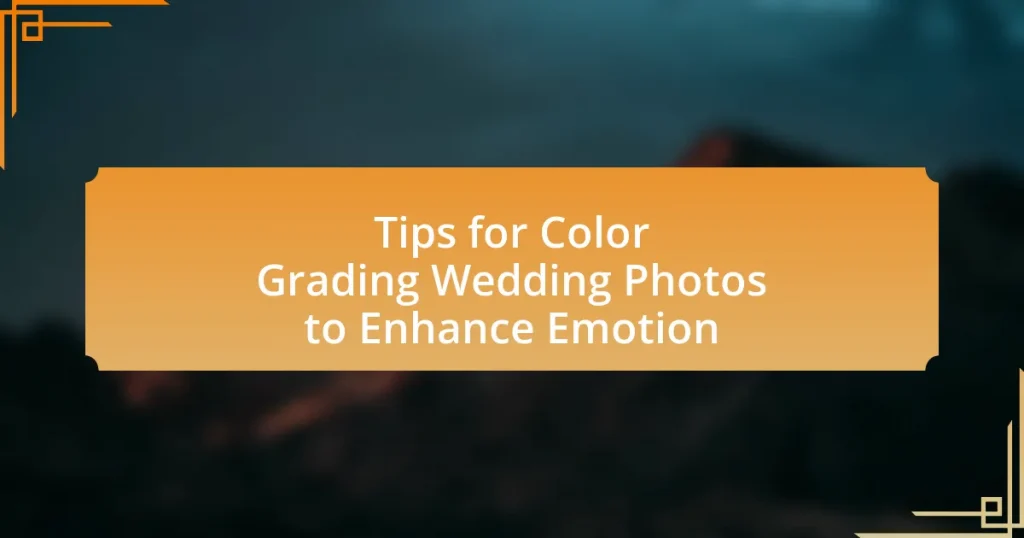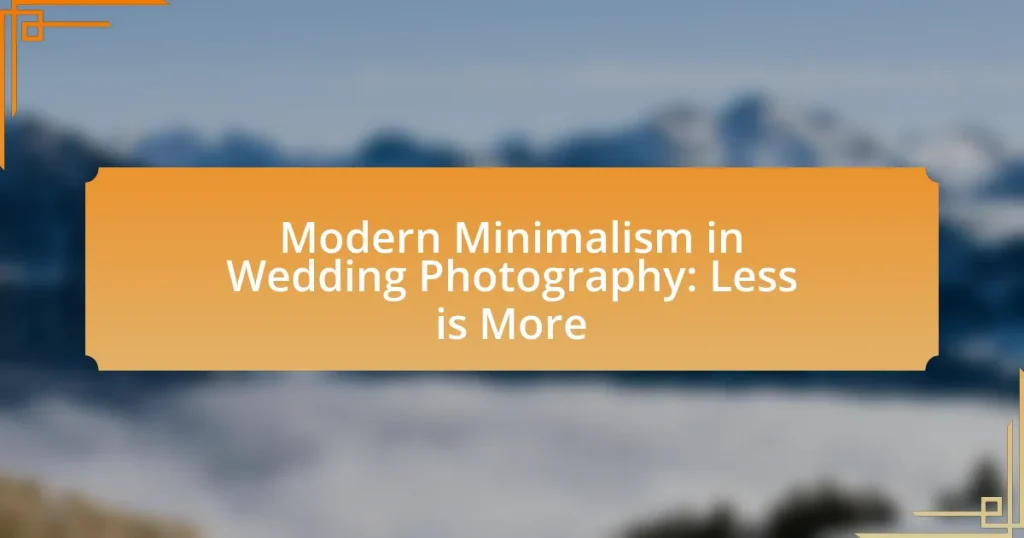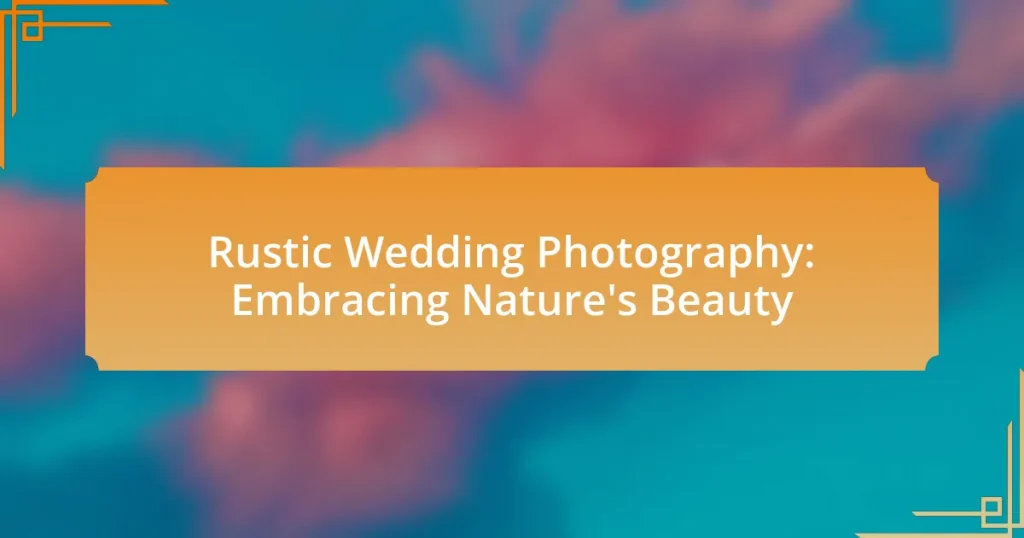Color grading in wedding photography is a crucial technique that involves adjusting colors and tones to evoke specific emotions and enhance the visual narrative of wedding images. This article explores the impact of color grading on emotional tone, detailing key elements such as hue, saturation, contrast, and color temperature that influence viewer perception. It also discusses popular color grading styles, effective techniques, and the importance of maintaining consistency across a wedding album. Additionally, the article highlights common mistakes to avoid and offers practical tips for photographers to achieve emotional resonance through color grading, ultimately enhancing the storytelling aspect of their work.
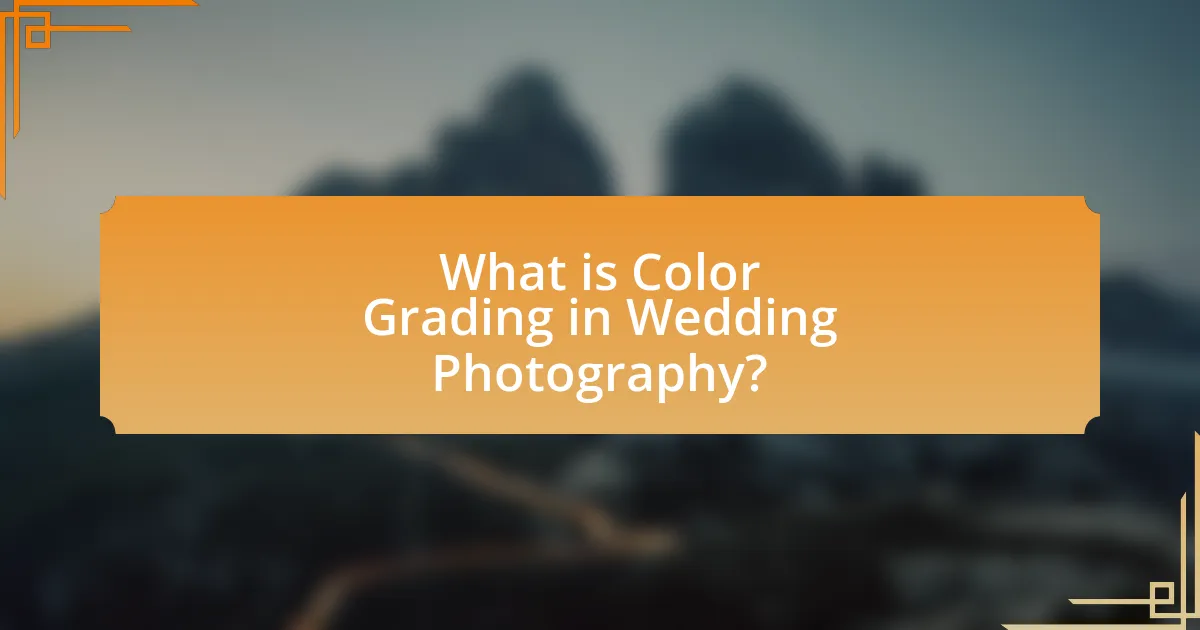
What is Color Grading in Wedding Photography?
Color grading in wedding photography is the process of adjusting the colors and tones in images to create a specific mood or aesthetic. This technique enhances the emotional impact of wedding photos by manipulating elements such as brightness, contrast, saturation, and hue. For instance, a warm color palette can evoke feelings of romance and nostalgia, while cooler tones may convey a more modern or serene atmosphere. The effectiveness of color grading is supported by studies showing that color can significantly influence emotional responses, making it a crucial aspect of visual storytelling in wedding photography.
How does color grading impact the emotional tone of wedding photos?
Color grading significantly impacts the emotional tone of wedding photos by altering the mood conveyed through color palettes. For instance, warm tones like soft yellows and oranges can evoke feelings of joy and intimacy, while cooler tones such as blues and greens may create a sense of calm or nostalgia. Research indicates that color psychology plays a crucial role in emotional perception; studies show that specific colors can trigger distinct emotional responses in viewers. Therefore, effective color grading can enhance the storytelling aspect of wedding photography, making the images resonate more deeply with the couple and their audience.
What are the key elements of color grading that influence emotion?
The key elements of color grading that influence emotion include hue, saturation, contrast, and color temperature. Hue affects the overall mood; for instance, warm hues like reds and oranges evoke feelings of warmth and happiness, while cool hues like blues and greens can create a sense of calm or sadness. Saturation impacts the intensity of colors; highly saturated colors can evoke strong emotions, while desaturated colors often convey a more subdued or nostalgic feeling. Contrast enhances visual interest and can heighten emotional responses; high contrast can create drama, while low contrast can evoke softness and intimacy. Lastly, color temperature influences the emotional tone; warmer temperatures can create a sense of comfort, while cooler temperatures can evoke detachment or melancholy. These elements are crucial in color grading to effectively convey the desired emotional narrative in wedding photos.
How do different color palettes evoke specific feelings in viewers?
Different color palettes evoke specific feelings in viewers by influencing emotional responses through color psychology. For instance, warm colors like red and orange can create feelings of warmth, excitement, and passion, while cool colors such as blue and green often evoke calmness, tranquility, and serenity. Research indicates that colors can significantly affect mood and perception; for example, a study published in the journal “Color Research and Application” found that warm colors are associated with increased energy levels, while cool colors are linked to relaxation. This understanding is crucial in color grading wedding photos, as selecting the appropriate palette can enhance the emotional impact of the images, making them resonate more deeply with viewers.
Why is color grading important for wedding photographers?
Color grading is important for wedding photographers because it enhances the emotional impact of images, creating a cohesive visual narrative. By adjusting colors, tones, and contrasts, photographers can evoke specific feelings that resonate with the couple and their story. For instance, warm tones can convey intimacy and romance, while cooler tones may evoke calmness and serenity. Studies show that color can influence perception and emotional response; for example, research published in the Journal of Experimental Psychology indicates that colors can significantly affect mood and feelings. Therefore, effective color grading not only beautifies wedding photos but also deepens the emotional connection viewers have with the images.
How does color grading enhance storytelling in wedding photography?
Color grading enhances storytelling in wedding photography by manipulating colors to evoke specific emotions and highlight key moments. This technique allows photographers to create a cohesive visual narrative that reflects the couple’s unique story and the atmosphere of the day. For instance, warm tones can convey intimacy and joy, while cooler tones might evoke nostalgia or calmness. Studies in visual perception indicate that color significantly influences emotional responses; for example, research published in the Journal of Experimental Psychology shows that colors can alter mood and perception, reinforcing the emotional impact of wedding imagery. Thus, effective color grading not only beautifies the images but also deepens the viewer’s emotional connection to the couple’s experience.
What role does color grading play in creating a cohesive wedding album?
Color grading plays a crucial role in creating a cohesive wedding album by ensuring that all images share a consistent visual tone and mood. This consistency enhances the storytelling aspect of the album, allowing viewers to experience the emotions of the day in a unified manner. For instance, applying a specific color palette across all photos can evoke particular feelings, such as warmth or nostalgia, which aligns with the overall theme of the wedding. Studies in visual perception indicate that color harmony can significantly impact emotional responses, reinforcing the importance of color grading in photography.
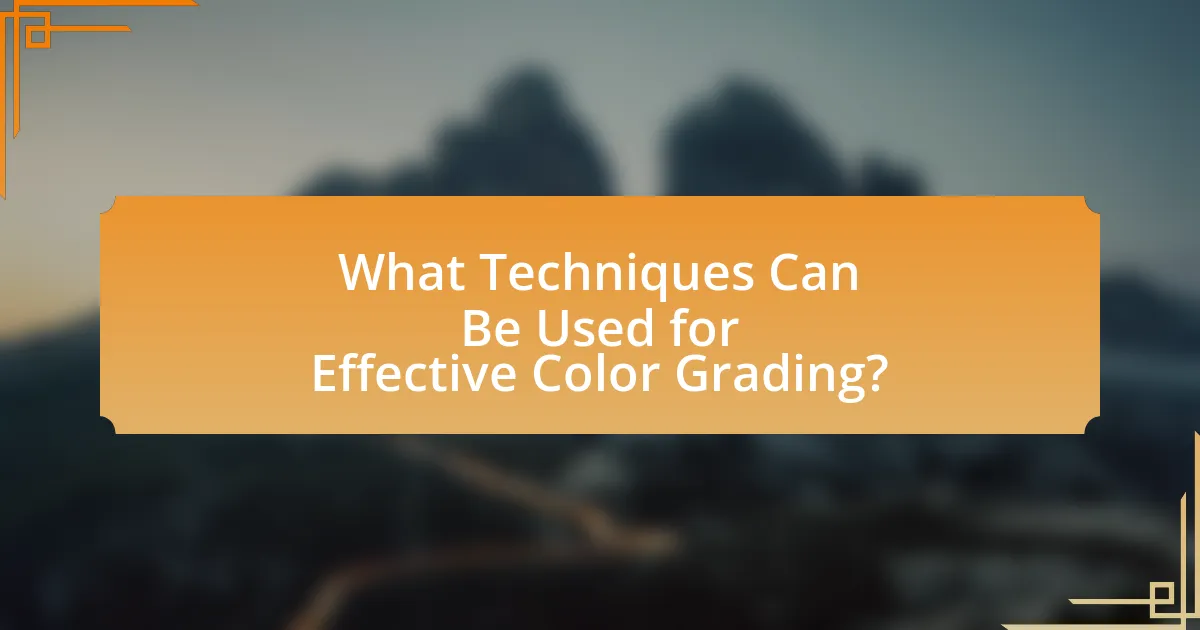
What Techniques Can Be Used for Effective Color Grading?
Effective color grading techniques include the use of color wheels, LUTs (Look-Up Tables), and selective color adjustments. Color wheels allow for precise control over shadows, midtones, and highlights, enabling the enhancement of specific color ranges to evoke desired emotions. LUTs provide a quick way to apply a specific color grade that can transform the overall mood of an image, often used in film and photography for consistency. Selective color adjustments enable the manipulation of individual colors within an image, allowing for targeted enhancements that can highlight important elements or create a specific atmosphere. These techniques are widely used in professional photography and videography to enhance emotional impact, as evidenced by their prevalence in industry-standard software like Adobe Premiere Pro and DaVinci Resolve.
How can photographers choose the right color grading style for a wedding?
Photographers can choose the right color grading style for a wedding by considering the couple’s preferences, the wedding theme, and the emotional tone they wish to convey. Understanding the couple’s vision helps in selecting a color palette that aligns with their style, whether it be vibrant, muted, or vintage. Additionally, the wedding theme, such as rustic or modern, influences the choice of color grading; for instance, earthy tones may suit a rustic wedding, while bright colors may enhance a contemporary setting. Research indicates that color grading can significantly impact emotional perception in photography, with studies showing that warm tones evoke feelings of happiness and intimacy, while cooler tones can create a sense of calm and elegance. Therefore, aligning the color grading style with the desired emotional response enhances the overall storytelling of the wedding photos.
What are the most popular color grading styles used in wedding photography?
The most popular color grading styles used in wedding photography include light and airy, moody and dark, vintage, and vibrant. Light and airy styles emphasize soft pastels and bright whites, creating a romantic and ethereal feel, often achieved through high exposure and reduced contrast. Moody and dark styles utilize deep shadows and rich colors to evoke a dramatic atmosphere, appealing to couples seeking a more intense emotional impact. Vintage styles incorporate faded colors and film-like grain, reminiscent of classic photography, often appealing to those who appreciate nostalgia. Vibrant styles focus on bold colors and high saturation, enhancing the liveliness of the wedding day. These styles are widely adopted by photographers to cater to diverse client preferences and to enhance the emotional storytelling of wedding imagery.
How do lighting conditions affect color grading choices?
Lighting conditions significantly influence color grading choices by altering the perceived color temperature and mood of an image. For instance, warm lighting, such as during golden hour, may prompt color graders to enhance warm tones like yellows and oranges to evoke a romantic atmosphere, while cooler lighting, such as overcast conditions, may lead to the emphasis of blues and greens to create a serene or moody effect. Research indicates that color grading can enhance emotional responses; a study published in the Journal of Vision found that color temperature affects emotional perception, with warmer colors often associated with happiness and cooler colors linked to sadness. Thus, understanding the lighting context allows color graders to make informed decisions that align with the desired emotional impact in wedding photography.
What tools and software are recommended for color grading wedding photos?
Adobe Lightroom and Adobe Photoshop are highly recommended tools for color grading wedding photos. These software programs offer advanced editing features, including color correction, tone adjustments, and creative filters that enhance the emotional impact of wedding images. Lightroom provides a user-friendly interface for batch processing and organizing photos, while Photoshop allows for more detailed adjustments and retouching capabilities. Both tools are widely used by professional photographers, ensuring their effectiveness in achieving high-quality results.
Which software offers the best features for color grading?
DaVinci Resolve offers the best features for color grading. It is widely recognized in the industry for its advanced color correction tools, including a powerful color wheel, HDR grading capabilities, and a comprehensive set of LUTs (Look-Up Tables). DaVinci Resolve’s node-based workflow allows for intricate adjustments and creative flexibility, making it a preferred choice among professional colorists. Additionally, its free version provides robust features, enabling users to access high-quality color grading tools without financial investment.
How can presets simplify the color grading process?
Presets simplify the color grading process by providing predefined settings that streamline adjustments for consistent results. These presets allow photographers to apply a specific look or mood to their wedding photos quickly, reducing the time spent on manual adjustments. For instance, using a preset can automatically adjust exposure, contrast, and color balance, ensuring that all images maintain a cohesive aesthetic. This efficiency is particularly beneficial in wedding photography, where numerous images need to be edited in a short timeframe, allowing for a more efficient workflow and enhanced emotional impact in the final presentation.
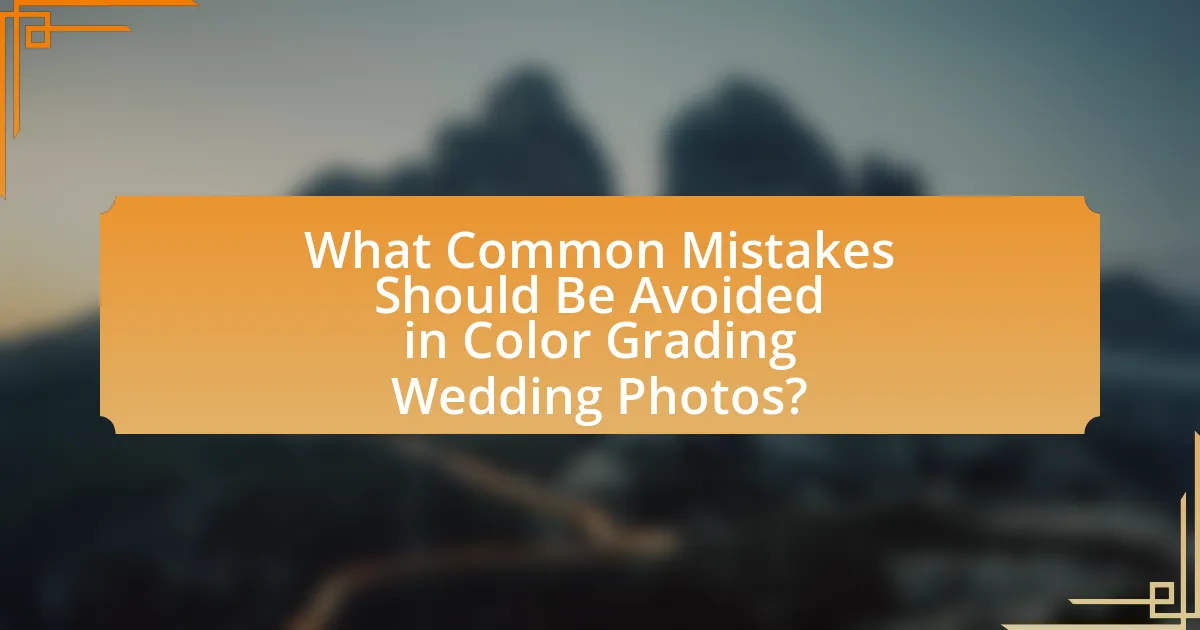
What Common Mistakes Should Be Avoided in Color Grading Wedding Photos?
Common mistakes to avoid in color grading wedding photos include over-saturation, inconsistent color tones, and neglecting skin tones. Over-saturation can lead to unnatural colors that detract from the emotional essence of the moment, while inconsistent color tones can create a disjointed look across a series of images, disrupting the visual narrative. Additionally, failing to maintain natural skin tones can result in unflattering images that do not accurately represent the subjects. These mistakes can diminish the overall quality and emotional impact of wedding photography, making it essential for photographers to focus on balanced and cohesive color grading techniques.
What are the pitfalls of over-editing wedding photos?
Over-editing wedding photos can lead to unnatural appearances and loss of authenticity. When photographers excessively manipulate colors, contrast, or sharpness, the images may appear overly processed, detracting from the genuine emotions captured during the event. This can result in a disconnection between the viewer and the moment, as the essence of the day is overshadowed by artificial enhancements. Additionally, over-editing can introduce artifacts or distortions, compromising image quality and making them less suitable for printing or display.
How can photographers maintain a natural look while color grading?
Photographers can maintain a natural look while color grading by using subtle adjustments to enhance the existing colors without overwhelming them. This involves focusing on preserving skin tones, which should remain true to life, and avoiding extreme shifts in hue or saturation that can lead to an artificial appearance. Techniques such as using adjustment layers in software like Adobe Lightroom or Photoshop allow for targeted edits, enabling photographers to fine-tune specific areas while keeping the overall image balanced. Additionally, utilizing color grading tools that mimic film characteristics can help achieve a more organic feel, as these tools often emphasize natural color relationships.
What signs indicate that color grading has been overdone?
Signs that indicate color grading has been overdone include unnatural skin tones, excessive contrast, and unrealistic color saturation. Unnatural skin tones often appear overly orange or green, which detracts from the authenticity of the image. Excessive contrast can lead to loss of detail in shadows and highlights, making the image look harsh. Unrealistic color saturation can result in colors that are overly vibrant or distorted, creating an artificial look that distracts from the subject. These indicators suggest that the color grading process has compromised the integrity of the photograph, making it less appealing and emotionally resonant.
How can photographers ensure consistency in color grading across an album?
Photographers can ensure consistency in color grading across an album by utilizing a standardized color grading workflow and applying the same presets or adjustments to all images. This approach allows for uniformity in tones, saturation, and contrast throughout the album. For instance, using software like Adobe Lightroom or Capture One enables photographers to create and save specific presets that can be applied to multiple images, ensuring that the same color grading style is maintained. Additionally, monitoring the color temperature and exposure settings during the shoot helps to minimize variations in lighting conditions, further contributing to a cohesive look.
What techniques help maintain a uniform color palette throughout the wedding photos?
To maintain a uniform color palette throughout wedding photos, photographers can utilize techniques such as consistent lighting, color grading in post-processing, and careful selection of backgrounds and attire. Consistent lighting ensures that colors appear uniform across different settings, while color grading allows for adjustments to hues and saturation to create a cohesive look. Additionally, selecting backgrounds and attire that complement the chosen color scheme helps reinforce the overall palette. Research indicates that a well-coordinated color palette can enhance emotional responses in viewers, making these techniques essential for impactful wedding photography.
How can batch processing aid in achieving consistency?
Batch processing aids in achieving consistency by allowing photographers to apply the same color grading settings across multiple images simultaneously. This method ensures that all photos maintain a uniform look and feel, which is crucial for wedding photography where a cohesive aesthetic enhances emotional storytelling. For instance, using software like Adobe Lightroom, photographers can create presets that standardize exposure, contrast, and color tones, resulting in a harmonious visual narrative throughout the wedding album. This approach not only saves time but also minimizes the risk of discrepancies that can arise when editing images individually.
What are some practical tips for color grading wedding photos effectively?
To effectively color grade wedding photos, start by establishing a consistent color palette that reflects the mood of the event. This can be achieved by selecting a base color that complements the wedding theme, such as soft pastels for a romantic feel or vibrant hues for a lively atmosphere. Next, adjust the exposure and contrast to enhance the details in both highlights and shadows, ensuring that skin tones remain natural and flattering. Utilize tools like curves and color balance to fine-tune the overall look, focusing on maintaining a cohesive aesthetic throughout the album. Finally, apply subtle color grading techniques, such as split toning, to evoke specific emotions; for instance, warm tones can create a sense of intimacy, while cooler tones may convey elegance. These methods are supported by industry practices that emphasize the importance of emotional resonance in wedding photography, as seen in the work of renowned photographers who prioritize color grading to enhance storytelling.
How can photographers experiment with color grading to find their unique style?
Photographers can experiment with color grading by utilizing various software tools to manipulate hues, saturation, and contrast, allowing them to develop a distinctive visual style. By applying different color grading techniques, such as split toning or using LUTs (Look-Up Tables), photographers can create specific moods that resonate with their artistic vision. For instance, a study by the International Journal of Arts and Technology highlights that color grading can significantly influence viewer emotions, suggesting that tailored color palettes can enhance storytelling in wedding photography. This experimentation not only helps in refining their style but also in connecting more deeply with their audience through emotional resonance.
What best practices should photographers follow for emotional impact in color grading?
Photographers should utilize a limited color palette to enhance emotional impact in color grading. By focusing on specific hues that evoke particular feelings—such as warm tones for intimacy or cool tones for calmness—photographers can effectively convey the desired mood of the wedding photos. Research indicates that color psychology plays a significant role in emotional perception; for instance, red can evoke passion, while blue can instill tranquility. Additionally, adjusting contrast and saturation can further amplify emotional responses, as higher contrast often creates drama, while softer saturation can evoke nostalgia. These practices are supported by studies in visual perception, which demonstrate that color choices directly influence viewer emotions and interpretations.
